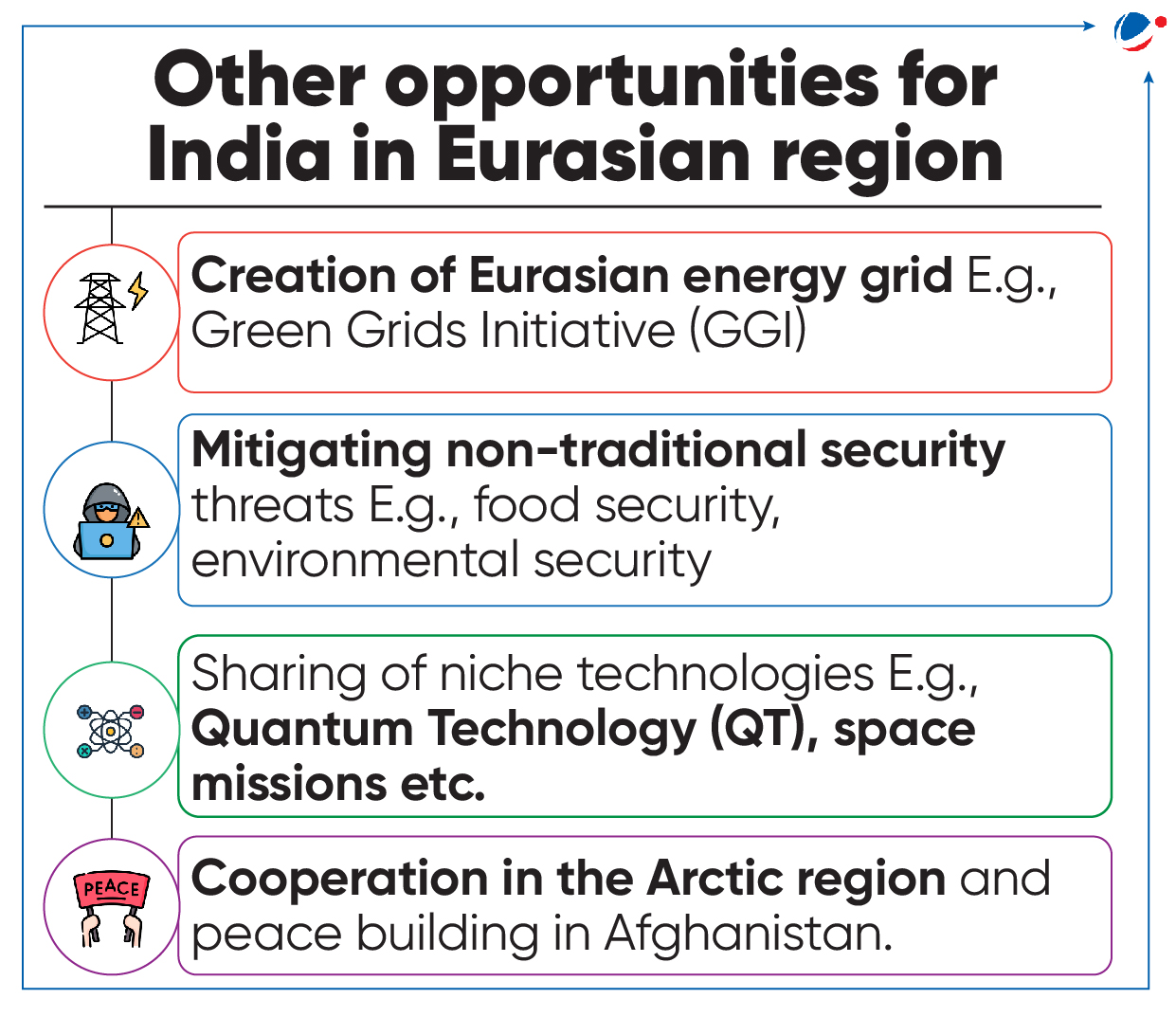Why in the news?
The complex and deepening interconnections between European and Asian security offer new strategic opportunities for countries like India.
Factors highlighting the Changing geopolitics of the Eurasian region

- Hotbed of conflicts: E.g., the Russia-Ukraine conflict and the Armenia- Azerbaijan conflict (Nagorno-Karabakh), which have significant geopolitical implications.
- Growing Chinese influence: China's Belt and Road Initiative, extending across Central Asia and Russia to the Atlantic shores, along with Europe's increasing economic ties with China, has significantly strengthened China's influence in Eurasia.
- Changing strategic priorities of US: Geopolitical instances such as withdrawal from Afghanistan, shifting focus from Middle East to Eurasia and Indo-Pacific, Strengthening NATO and involvement in the Three Seas initiative in the context of Ukraine war.
- Regional geostrategic alliances: E.g., China and Russia 'no limits' partnership to counter the USA; emergence of a Russia-Iran-China axis, China-Iran-Russia-Turkey-Pakistan strategic pentagonal etc.
- Tilt in Russia's foreign policy toward Asia: It is evident in the recent visits of the Russian president to North Korea and Vietnam.
- Alignment of East Asian countries with Western European: Japan, South Korea and Australia (through AUKUS) are eager to bring Europe into Indo-Pacific, bridging the divide between Asia and Europe.
- Shift of global order towards Eurasia: E.g., India-Middle East- Europe Economic Corridor (IMEC) signifies the commitment of the US, Europe, and emerging powers such as India, Saudi Arabia, and the UAE to promoting a more balanced and interconnected Eurasian order.
Opportunities for India in the evolving landscape
Strategic
- Strengthening ties with Russia as a counterbalance to China: India now must take advantage of its relationship with Russia to mediate an end to the Ukraine war.
- Integrated deterrence" strategy of US: It seeks strong security partnerships with middle powers to balance China and Russia, which can offer India a chance to boost its national power and military capabilities.
- Strategic Partnerships: E.g., India's growing defence partnership with Armenia can encourage developments in India's Eurasia strategy
Economic
- Energy Security: Eurasian especially Central Asian States are prospective long-term partners of India in energy (oil, natural gas) and natural resources (uranium and iron ore).
- Enhanced Trade with Russia: India and Russia are looking to raise bilateral trade to $100 billion by 2030, thereby mutually deepening relationship.
- Improved trade and connectivity: It is estimated that if India and the Eurasian Economic Union sign a Free trade agreement (FTA) while the International North-South Transport Corridor (INSTC) also becomes fully functional, India's two-way trade with Eurasia could reach $170 billion from the current figure of around $20 billion.
- Market expansion: Exporting IT services and digital solutions to Eurasian markets.
- Regional Security: Collaborating with Central Asia to counter terrorism, extremism, and drug trafficking is crucial for regional security and India's national interests
- Cultural diplomacy: Leveraging historical and cultural ties (through Buddhism, yoga) to build soft power, as India shares ancient ties with Eurasian countries.

What are the challenges in the evolving Eurasian landscape for India?
- Geographical Connectivity and Infrastructure: Lack of geographical connectivity and slow progress on connectivity projects like INSTC, IMEC etc.
- Pakistan Factor: Overcoming the geographic limitation represented by the Pakistan barrier, will be central to an expanded Indian role in Eurasian geopolitics.
- Threats from China: BRI challenges India's strategic extended neighbourhood initiative such as Connect Central Asia Policy, forcing India to look for alternatives.
- Challenges in Indo-Russia relations: This includes Russia's growing proximity to China and India's perceived tilt towards the US or QUAD.
- Balancing Strategic Partnerships: Ensuring India's autonomy while managing divergent interests and aligning with both maritime (e.g., QUAD) and continental coalitions (e.g., Shanghai Cooperation Organisation).
Way Forward
- Enhance connectivity: India should consider joining Russia's Greater Eurasian corridor and the Northeast Passage to establish connections to the Far East and Japan.
- Strengthening relations with the European Union (EU): India's Eurasian policy should include enhanced engagement with EU.
- Central Asia as the Core of India's Eurasian Strategy: The India-Central Asia Summit can be held annually instead of biannually, similar to the India-ASEAN Summit.
- Balancing different regions: India needs to balance its Connect Central Asia policy with its Act East Policy and Indo-Pacific Strategy.
- Being an important member of BRICS, SCO, and RIC (Russia-India-China), India must utilize the platforms to promote multi-dimensional strategic cooperation with Russia and China.
- Intensifying dialogues with Russia: India and Russia should focus on narrowing disagreements and expanding cooperation on continental Eurasian security.



